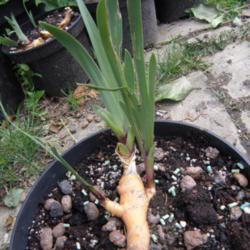@evelyninthegarden. I mentioned hybrid 'Aril- bred', in an attempt to explain the hybridization with standard Iris. But, because the way Regeliocyclus is spelled, indicates it is a hybrid between 'sections' within the group, classified together, from Eastern Mediterranean, into the Caucasus of Asia & other rather dry areas.. The last part, being a name ; 'Dardanus', meaning it is a culitvar...
Going back 30 years ago, I recall what the roots looked like of 'Mourning Iris'. May have been called species Susianus, back then ? That is an Iris in the section Oncocyclus, I believe. Then supposedly an Iris plant from the section Regelio-...One was pollinated with the other & a hybrid was grown from the resulting Aril form of seed.
That rhizomatous-root actually looks almost more like a cross with a bearded Iris! That is to say, it appears more like the typical rhizome of bearded.... But since the claim is the crossed were the Regelio... x Oncocyclus, which appear more like a clumpthe smaller root portion where only the leaves arise from. The Onco, I had of these wild Iris species (had tightly clumped, groups of leaves sprouting closely together,, ) Within those numerous 'sections', they actually grow in quite different areas, from rather vast distance apart!
See Pacific Bulb Society webpage regarding this subject. What the Aril Iris do share most in common & why they are grouped together, was, I think the seeds & a basal blotch on the falls of the petals, (with noticeably pronounced veining, in my opinion) Nothing like English Iris bulbs, nor those early spring flowering tiny ones, either..... I don't give these plants names. That is by a book of Botanical Nomenclature, done by a Committee.
Lastly, due to the fact they can be hyridized, even with typical standard Iris, or those classified within the Aril sections, doesn't necessarily make 'Dardanus', a 'species'. found in nature.
Hope this helps. Shawn (lacking sleep)

